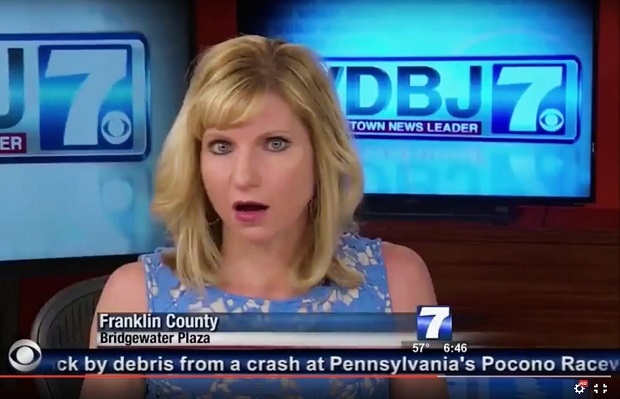
In this image made from video and provided by WDBJ-TV7 news, Kimberly McBroom, the station’s morning anchor in Roanoke, Va., reacts to a live broadcast during which reporter Alison Parker and cameraman Adam Ward were fatally shot, Wednesday, Aug. 26, 2015. McBroom tried to reassure viewers immediately after the attack, carried out by Vester Lee Flanagan II, a former WDBJ-TV reporter known to viewers by his on-air name Bryce Williams. AP
NEW YORK — In an era when anyone can go online and find video of terrorist beheadings, police shootings and other carnage, major news organizations applied their own standards to coverage of this week’s killing of a TV news crew in Virginia and showed only carefully selected portions of the footage.
By all accounts, they were difficult newsroom decisions, informed by competitive pressures, questions of newsworthiness and taste, and an understanding that for all the talk about the great convergence of media, a fundamental difference still exists between TV and the Internet.
READ: Deadly US shooting becomes ghoulish Internet hit
“We went back and forth on this — whether to run it, not run it, or just use frame grabs,” said Al Ortiz, CBS vice president of standards and practices. “It’s not a decision you make lightly. An argument was made that we were doing the gunman’s work for him. But the decision we came around to was that it was editorially important to show how methodical, planned and deliberate this was. That’s the only reason we used it.”
The killings of WDBJ reporter Alison Parker and cameraman Adam Ward were literally a made-for-television moment. They were shot to death on live TV by a gunman who also recorded the attack and posted his video on social media. The TV station’s footage and the gunman’s were watched online in full by countless numbers of people around the globe as news executives decided what to show.
Before the shooting was three hours old, CNN began showing WDBJ’s footage of Parker conducting an interview and then trying to scramble away as gunfire erupted. The network warned viewers of its graphic nature and promised not to air it more than once an hour. CNN did not air the gunman’s own video.
Some news organizations, like CBS and NBC, ran a portion of the WDJB video but did not use audio of the shooting and screaming. ABC froze the video before the shooting began but aired audio of the attack. CBS showed part of the gunman’s footage but stopped it before the first shot, Ortiz said.
Fox News used no video or audio of the event during daytime hours but, after 6 p.m., used a combination of video before the attack, still photos and audio. NBC and MSNBC froze the video and audio before the attack, but a gunshot could be heard on its websites.
The differences in the way TV and the Internet handled the material are important, executives said: People online are making conscious choices about what to see, while TV viewers can be taken by surprise.
“You don’t know who’s in the room,” said former CBS News President Andrew Heyward, now a consultant to media companies. “You don’t know the ages of the people watching. So there’s always been a very high standard of restraint.”
The Associated Press provided to the public a version of the gunman’s video that froze when the shooting began, but continued with audio. For broadcast subscribers, the AP supplied complete version through a closed-circuit channel, allowing TV stations to edit it to their own standards, said Tom Kent, AP’s standards editor.
“The video was newsworthy and key to understanding the story,” he said.
Many journalists argue that their job is to be a pipeline of news to the public, not a filter. Marcy McGinnis, a former news executive at CBS and Al Jazeera America, said she wonders if the public reaction to events like the Connecticut school shooting would have been different if pictures had been more readily available.
But McGinnis said news organizations aren’t YouTube, and people expect professionals to weigh issues of taste along with the need to tell stories.
“I can see people arguing for showing more things on TV if it’s available everywhere else,” she said, adding: “I still don’t think I would show somebody getting shot or show the face of a dead person.”
Broadcasters also are constrained by government licensing of the airwaves, Heyward noted. Too many complaints from the public aren’t good. In fact, professional editing is a way for networks to distinguish themselves from online outlets, he said.
Meanwhile, a newspaper front page Thursday proved that still photography retains the capacity to shock.
The New York Daily News ran the headline “Executed on Live TV” with three pictures of Parker from the point of view of the gunman. One had a gun raised and pointed at her, the other showed the moment the gun went off, and the third illustrated her horrified face when she saw what was happening.
Daily News spokeswoman Anne Muscarella said the decision wasn’t made lightly and noted the images were widely circulated online.